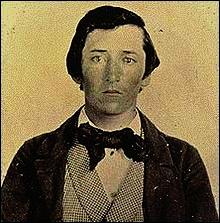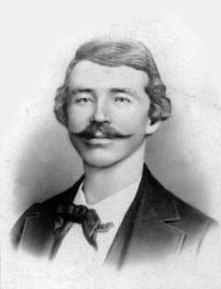|
 
Quantrill's Raiders (Confederate Bushwackers)
William Clarke Quantrill (July 31, 1837 - June 6, 1865), was a Confederate guerrilla leader during the American Civil War. After leading a Confederate bushwhacker unit along the Missouri-Kansas border in the early 1860's, which included the infamous raid and sacking of Lawrence, Kansas in 1863, Quantrill eventually ended up in Kentucky where he was killed in a Union ambush in 1865, aged 27.
Quantrill's Raiders were a loosely organized force of pro-Confederate Partisan rangers "bushwhackers" who fought in the American Civil War under the leadership of William Clarke Quantrill. The name "Quantrill's Raiders" seems to have been attached to them long after the war, when the veterans would hold reunions.
Origins
The Missouri-Kansas border area was fertile ground for the outbreak of guerrilla warfare when the Civil War erupted in 1861. Historian Albert Castel wrote:
For over six years, ever since Kansas was opened up as a territory by Stephen A. Douglas' Kansas-Nebraska Bill of 1854, its prairies had been the stage for an almost incessant series of political conventions, raids, massacres, pitched battles, and atrocities, all part of a fierce conflict between the Free State and proslavery forces that had come to Kansas to settle and to battle.
In February 1861 Missouri voters elected delegates to a statewide convention which rejected secession by a vote of 89-1. Unionists, led by regular U.S. army commander Nathaniel Lyon and Frank Blair of the politically powerful Blair family, and increasingly pro-secessionist forces, led by governor Claiborne Jackson and future Confederate general Sterling Price, contested for the political and military control of the state. By June there was open warfare between Union forces and troops supporting the Confederacy. Guerilla warfare immediately erupted throughout the state and intensified in August after the Union defeat at the Battle of Wilson's Creek.
By August 1862, with the Union victory at the Battle of Pea Ridge, the state was free of significant regular Confederate troops but the violence in Missouri continued. One historical work describes the situation in the state after Wilson's Creek:
Unlike other border areas in Maryland and Kentucky, local conflicts, bushwacking, sniping, and guerilla fighting marked this period of Missouri history. "When regular troops were absent, the improvised war often assumed a deadly guerilla nature as local citizens took up arms spontaneously against their neighbors. This was a war of stealth and raid without a front, without formal organization, and with almost no division between the civilian and the warrior." The most notorious of these guerilla forces was led by William Clarke Quantrill.
Methods and Legal Status
Quantrill was not the only Confederate guerrilla operating in Missouri, but he rapidly won the greatest renown. He and his men ambushed Union patrols and supply convoys, seized the mail, and occasionally struck towns on either side of the Kansas-Missouri border. Reflecting the internecine nature of the guerrilla conflict in Missouri, Quantrill directed much of his effort against Unionist civilians, attempting to drive them from of the territory where he operated. Under his direction, Confederate partisans also perfected military tactics such as coordinated and synchronized attacks, planned dispersal after an attack using pre-planned routes and relays of horses, and other technical methods, including the use of the long-barreled revolvers that later became the preferred firearm of western lawmen and outlaws alike. The James-Younger Gang, many of whose members had ridden with Quantrill, applied these same techniques after the war to the robbery of trains and banks.
Quantrill was designated as a captain and the other officers were elected by the men. Despite the legal responsibility assumed by the Confederate government, Quantrill often acted on his own with little concern over what his government's policy or orders might be. His most notable operation was the Lawrence Massacre, a revenge raid on Lawrence, Kansas in August 1863.
For years Lawrence had been the base of operations of Unionist irregular raids by Redlegs and Jayhawkers into Missouri both before and during the war. Also, just a month prior to the raid, some family members-women and children-of Quantrill's men who had been illegally held as hostages by Unionist forces in a dilapidated and overcrowded Kansas City prison, had been killed when that building had collapsed. Quantrill, calling for revenge for years of such atrocities against Missourians at the hands of Redleggers and Jayhawkers, organized a unified partisan raid on Lawrence, Kansas, the center of these Union forces. Hundreds of Missouri riders rallied to the cause. Coordinating across hundreds of miles, individuals and small bands of partisans rode over three hundred miles to rendezvous on Mt. Oread in the early morning hours before the raid. Men had loaded multiple pistols which they stuffed into their shirts, and had tied themselves into their saddles to keep themselves from falling off their horses as they lapsed into sleep from exhaustion. While no women were harmed in the raid, Quantrill's men burned a quarter of the town, and summarily dragged out of their homes and shot, according to Union records, 167 men and teenage boys. One of the main targets of the raid, Abolitionist Senator Jim Lane, escaped by fleeing into the cornfields. The Lawrence raid was the most successful unified effort of Missouri's Southern guerrillas, and the feat marked the high point of their service. Nevertheless, the Confederate leadership appeared to have been appalled by the raid, and withdrew even tacit support from the Missourians. Following the raid, in the winter of 1863-64, Quantrill led his men behind Confederate lines into Texas. There, their often lawless presence proved an embarrassment to the Confederate command.
Yet many Confederate officers appreciated the effectiveness of these Missouri irregulars against Union forces, which never gained the upper hand over them, especially Quantrill. Among these was the famed and heroic General Joseph O. Shelby, who rode south into Mexico with his troops rather than surrender at the end of the war, and whose command was remembered as "The Undefeated". Their exploits are also immortalized in a later addition to the defiant post-war Confederate ballad, "The Unreconstructed Rebel:"
"I won't be reconstructed--I'm better now than then. And for that Carpetbagger I do not care a damn. So it's forward to the Frontier soon as I can go. I'll fix me up a weapon and start for Mexico."
Among Quantrill's men was a free African American man named John Noland. He was one of Quantrill's scouts, indeed reputed to be his best one. It was Noland who helped in scouting Lawrence, Kansas, before the raid by Quantrill's men in 1863. He joined Quantrill's raiders because of the abuse his family suffered at the hands of Kansas Union Jayhawkers. Post-war pictures show him sitting with his comrades at reunions of the Raiders. In the 1999 movie Ride with the Devil depicting a group of fictionalized Missouri bushwhackers similar to those of Quantrill's Raiders, as well as the Lawrence raid, the character of Daniel Holt was representative of Quantrill's John Noland. Although some criticized the film for its depiction of this Black Confederate, Director Ang Lee clearly depicts Holt's awkwardness in fighting for the Southern cause, as well as the racism of some of the Bushwhackers toward Holt. The film's recreation of the raid on Lawrence, Kansas, and its aftermath is the best done to date, including the historic rendezvous on Mt. Oread.
Dissolution and Aftermath
During that winter, Quantrill lost his hold over his men. In early 1864, the guerrillas that he had led through the streets of Lawrence returned to Missouri from Texas in separate bands, none of them led by Quantrill himself (as Bloody Bill Anderson seems to have assumed general command by this time). Though Quantrill would gather some of his men again at the very end of 1864, the days of Quantrill's Raiders were over.
Quantrill died at the hands of Union forces in Kentucky in May 1865, but his legacy would live on. Many of his men, including Frank James, rode in 1864 under one of his former lieutenants, "Bloody Bill" Anderson, who was killed in October 1864. Much of that group remained together under the leadership of Archie Clement, who kept the gang together after the war, and harassed the Republican state government of Missouri during the tumultuous year of 1866. In December 1866, state militiamen killed Clement in Lexington, Missouri, but his men continued on as outlaws, emerging in time as the James-Younger Gang.
For More Information:
Bushwackers/Quantrill's Raiders (Confederate Bushwackers)
|